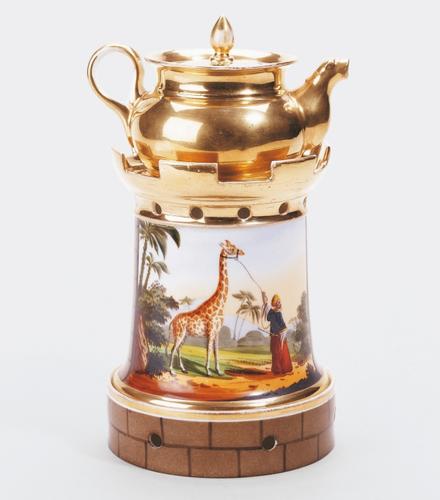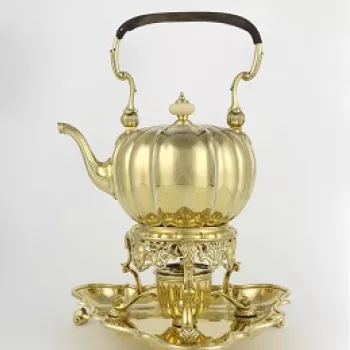Veilleuse nineteenth century
Hard-paste porcelain and gilding | 22.4 x 12.9 x 11.4 cm (whole object) | RCIN 36057
-
A porcelain veilleuse, in the form of a gilded teapot and cover with a tubular base. The veilleuse is in three parts: the top component is a bulbous tea pot with, at the bottom, a tubular extension which slots into the middle section in the form of a tower tapering towards the top with flared crenellations. This in turn slots into a circular base. Six oculi are pierced in the base and twelve in the tower below the crenellations. To keep tea warm a burner would have been concealed within the hollow base. The extension to the bottom of the teapot was designed to bring the contents closer to the flame. The burner is most likely to have been a small ceramic vessel filled with oil and fitted with a floating wick. The oculi act as air vents.
The teapot has a spout in the form of an animal’s head; it is fitted with a loop handle and an oval-shaped knob to its cover. It is gilded throughout except for the tubular extension and the inner surface of the handle. The tower and base are painted in imitation of masonry (pale brown with dark brown interstices), the former interrupted by a scene of a giraffe in a landscape setting. The animal, with a halter round its neck, is being led past a palm tree by an Egyptian man, who holds in his free right hand a long-stemmed pipe. He wears a blue jacket, golden-coloured turban and brick red trousers.
The scene recalls a topical event, namely the arrival in France of a live giraffe, the first ever to reach those shores. In 1824 Charles X let it be known that he wished to enrich the royal menagerie. It occurred to Bernardino Drovetti, the French consul in Egypt, that it would not come amiss if the europhile Pasha of Egypt, Mohammed Ali, were to seize this opportunity to offer the French monarch a giraffe. The suggestion so pleased the Pasha that he decided to make a similar offering to the British monarch, George IV. So it came to pass that two calves were captured in the upper reaches of the Nile and were ferried by slow stages to Alexandria. The giraffe, destined for George IV, proved to be of sickly disposition, whereas the other, intended for Charles X, enjoyed good health.
For the journey from Alexandria to Marseille, the giraffe, who was a female, was accompanied by two handlers, Hassan and Atir, three milk cows to provide her with sustenance and two antelopes for company. The vessel arrived off Marseille on 25 October 1826. She disembarked six days later and was greeted by the prèfet. Her arrival caused a considerable stir. Her gentle disposition and her affectionate nature were much commented upon. She even played a part in the social scene, notably at the dinner parties known as soirées à la Girafe to which the prèfet invited a select company. It was not till 20 May 1827, when the prèfet was finally prevailed upon to release her, that she set off with her entourage on the long journey on foot to Paris, dressed in a two-piece raincoat emblazoned with the French royal arms.
The journey was something of a triumphal progress – where she passed she caused a sensation. Streets and squares, as well as taverns and inns, were renamed after her. When she finally reached the capital on 30 June 1827 she was temporarily housed in a greenhouse in the grounds of the Jardin du Roi. Then on 9 July she was paraded through the streets of Paris on her way to meet her new master, the King of France.
The giraffe took Paris by storm. Between June and October 1827 there was hardly an edition of the weekly Journal des Dames et des Modes which did not mention her. Readers were kept fully informed about her appearance, the elegance of her deportment, the crowds she attracted and the changes of fashion she provoked. Dresses with garnitures à la giraffe, which were higher at the front than the back, were introduced. A hairstyle à la Girafe was born, while a beauty accessory, the last word in chic, was created, namely a necklace à la Girafe. Women graced with large, soft, oval, melting black eyes were described as having des yeux à la girafe.
Such was the appeal of the giraffe that she became a popular subject for print sellers and was reproduced in a wide variety of media: as giraffe-shaped gingerbread biscuits, on paperweights, bags, textiles, wall coverings and ceramics.
By 20 August 1827 the Journal des Dames was noting a slight falling-off of public interest in the doings of the animal in favour of another attraction, a group of Native Americans of the Osage tribe who had taken up temporary residence in a hotel on the rue de Rivoli.
The giraffe died on 12 January 1845. She survives, preserved by a taxidermist, on the landing of a staircase of the Musée Lafaille at La Rochelle.
Text adapted from French Porcelain: In the Collection of Her Majesty The Queen, London, 2009Provenance
Given by Queen Mary to the Windsor Castle Collection 1930
-
Creator(s)
-
Medium and techniques
Hard-paste porcelain and gilding
Measurements
22.4 x 12.9 x 11.4 cm (whole object)
Category
Other number(s)
Place of Production
Paris [Île-de-France]










